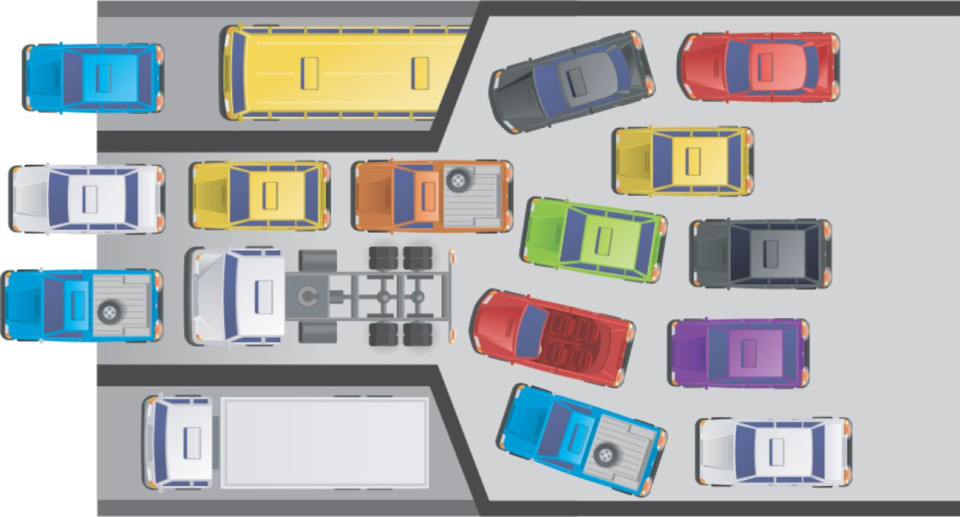Sagor Hossain started for Farmgate from Shantinagar around 2:00pm yesterday. He chose that particular time for the journey mainly to avoid the rush-hour traffic.
As expected, the man enjoyed a smooth ride on the Mouchak-Moghbazar flyover. He drove to Banglamotor in just three to four minutes, skipping Malibagh, Mouchak and Moghbazar intersections.
His euphoria over making so much ground in so little time did not last long as he got stuck at the off-ramp of the flyover. He had to wait more than 25 minutes before he could pass the Banglamotor insection. It used to take one-third time before, said Sagor, a driver.
Since the flyover was opened to traffic over a week ago, more and more vehicles are coming to that end to get on the Kazi Nazrul Islam Avenue, leading to an increased pressure of traffic at that point, said traffic sergeant Mahbub, who was on duty there.
To ease the situation, he said, “We are now giving more priority to the vehicles from the east [those coming from the New Eskaton side],” he said.

When vehicles from the flyover join the traffic on New Eskaton Road, they get stuck in tailback.
On his way back, Sagor had a faster trip around 4:40pm. Traffic was light at New Eskaton entry point where the car climbed up the flyover. He said he saw vehicles starting to line up on the flyover at the exit point.
A walk around Banglamotor, New Eskaton and Moghbazar areas on Thursday evening allowed this correspondent to see how the situation was like there in peak hours.
It was around 7:00pm. The evening rush was at its peak with cars and buses standing still on the flyover. Rickshaws, vans and jaywalkers clogged the entry and exit points of the flyover, making the situation worse.
Referring to situations like that, transport specialist Shamsul Hoque said flyovers should be built, keeping in mind that they bring relief to commuters during peak hours, but that is far from the reality seen in this case.

Shamsul, who worked as a consultant for constructing the 8.7-kilometre Moghbazar flyover built at a cost of Tk 1,219 crore, said the flyover was aimed at facilitating smooth travel of vehicles across intersections, but the advantage vehicles get by avoiding two-three intersections means nothing when they get stuck at the exits.
“The end result is zero.”
According to a recent analysis by the World Bank, road surface in the capital increased by only five percent, while the population by 50 percent between 1995 and 2005. As the traffic intensity has gone up by 134 percent, average traffic speed has dropped in the last 10 years from 21 km/hour to 7 km/hour, only slightly above the average walking speed.
This is the backdrop to the government taking up projects like flyover construction.
But in a city like Dhaka, flyovers are not a sustainable solution, said Shamsul, a professor of Bangladesh University of Engineering and Technology.
“It is rather an irreversible damage narrowing the prospect of Mass Rapid Transport [MRT] system inside the city.”
Dedicated lanes for buses in the MRT system, which has remained at the planning stage for nearly a decade now, could have ensured uninterrupted traffic movement inside the capital. The construction of flyovers could have also been aligned with the MRT plan to bring a permanent solution to the traffice problem.
But now pillars of the flyover are where the road space should have been dedicated to the MRT, Shamsul added, expressing fear that whatever little relief the flyovers were bringing to city commuters would go away fast with the space created overhead becoming exhausted just like the road space under.
Following the inauguration of the Moghbazar-Mouchak flyover, there have been complaints of sufferings from local people, who drive out the gates of their premises and go straight to their destinations via Kazi Nazrul Islam Avenue.
“Unable to make a U-turn due to tailbacks, I have to make a 3km detour to go towards Farmgate where I work,” said Etrat Shahriar, who lives in New Eskaton.
Source: The Daily Star









